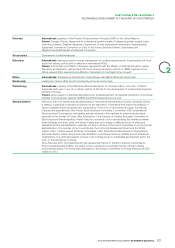APC 2015 Annual Report Download - page 48
Download and view the complete annual report
Please find page 48 of the 2015 APC annual report below. You can navigate through the pages in the report by either clicking on the pages listed below, or by using the keyword search tool below to find specific information within the annual report.
2015 REGISTRATION DOCUMENT SCHNEIDER ELECTRIC46
SUSTAINABLE DEVELOPMENT
2SUSTAINABLE DEVELOPMENT ATTHEHEART OFOURSTRATEGY
>
1. Sustainable development
attheheart ofourstrategy
Social and environmental commitments, governance, reducing
CO2 emissions, launching solutions that respect the planet, social
changes, local and regional positioning, corporate citizenship,
ethics, business and poverty – the challenges of sustainable
development have never been as signifi cant to Schneider Electric’s
customers and stakeholders as they are today.
The Group is committed to meeting energy challenges while
acting civically and responsibly at all its locations, with measured
progress plans, based on international standards for corporate
social responsibility, whose results are audited and shared openly
internally and externally.
Since the Sustainable Development Department was founded
more than 10years ago, the Group’s commitment to sustainable
development has evolved in line with the Group’s continuing
innovation. The Group’s sustainable development policy initially
focused on internal issues, teamed with initiatives for the professional
integration of French youth; now it also includes solutions that help
meet today’s main energy challenges (energy effi ciency and access
to energy) as well as global social responsibility.
Schneider Electric’s commitment to offering sustainable and
responsible solutions for its customers aims to:
•bring products and solutions to the market that waste less
energy and promote environmentally sound production and
consumption;
•provide energy to the 1.1billion(1) people who have no access to
electricity and provide sustainable economic development.
Schneider Electric’s corporate commitment means dynamic social
responsibility, based on the Group’s employees:
•principles governing ethics and responsibility;
•sites and products that respect the environment;
•employee development;
•policies that support and develop the communities in which
Schneider Electric operates.
Schneider Electric uses its global Human Resources policies (see
pages78-92 ), external commitments (see page55 ), ethical code
of conduct and the associated professional alert program (see
pages65-68 ) to strive for the respect of Human Rights in every
aspect: non-discrimination, abolition of forced labor, prohibition
of child labor, freedom of association and the right to collective
bargaining, health and safety, training, remuneration, social
coverage, etc.
Schneider Electric extends this commitment to civil society through
its community support and development program (see pages93-
103 ): the right to decent living standards (access to energy program
and Foundation emergency relief programs), the right to education
and training (training program for underprivileged people and
integration program in France), local economic development (social
investment funds and entrepreneurship support).
Schneider Electric works to share this vision with its partners (see
pages63-64 ), starting with its suppliers by encouraging as many of
them as possible to sign the United Nations Global Compact and
adopt the guidelines of ISO26000.
In November2015, on the eve of the United Nations Conference
on Climate Change (COP21), Schneider Electric stepped up its
sustainable development objectives with the goal of achieving a
carbon neutral balance across all of its sites within the next 15 years.
The Group presented its 10 commitments. In accordance with
the Planet & Society barometer , Schneider Electric’s sustainable
development dashboard since 2005, these commitments are in line
with the «two degree» climate change target and contribute to the
United Nations sustainable development g oals:
1. quantify the carbon footprint of 100% of major customer
projects;
2. design 100% of new offers in accordance with the Schneider
Electric ecoDesign Way™ and ensure that 75% of product
revenue is labeled Green Premium™;
3. prevent the emission of 120,000 metric tons of CO2 by setting up
product «end of life» services in accordance with the principles
of the circular economy;
4. facilitate access to lighting and communication for 50 million
people at the base of the pyramid over the next 10 years thanks
to low carbon solutions;
5. implement energy storage initiatives to develop renewable
energies and micro-grids;
6. propose alternatives to the use of SF6 gas over the next fi ve
years and phase out the use of SF6 gas in Schneider Electric
products over the next 10 years;
7. reduce Schneider Electric’s energy intensity by 3.5% a year;
8. reduce Schneider Electric’s CO2 emissions due to transport by
3.5% a year;
9. invest EUR10 billion in innovation and R&D for sustainable
development over the next ten years;
10. issue a «climate» bond to fi nance low carbon R&D for all of
Schneider Electric’s activities.
For Schneider Electric, these 10 commitments are also a way of
building a coherent industrial ecosystem by engaging suppliers
and customers in two key challenges:
–encouraging and supporting stakeholders in reducing their
own energy consumption by 30% through the implementation
of active energy effi ciency solutions,
–improving the lives of underprivileged individuals by bringing
them access to clean energy or helping them out of fuel
poverty .
The progress made on these commitments will be published
either as part of the Planet & Society barometer or in a specifi c
communication.
(1) Source: SE4All - Global tracking framework 2015 report.
























